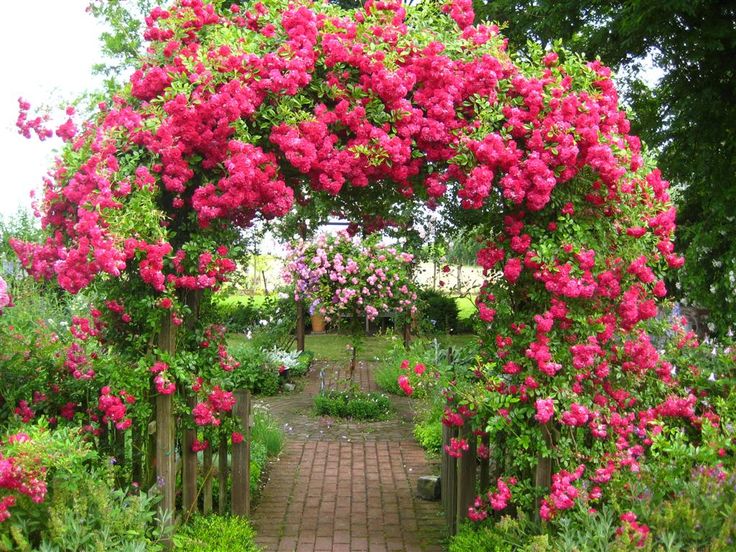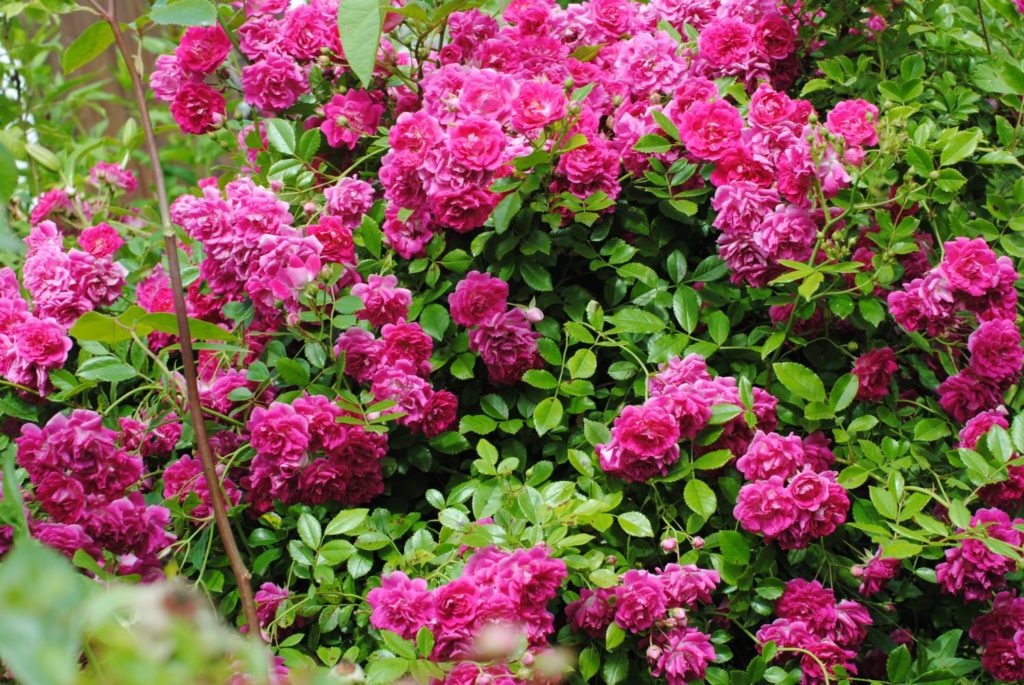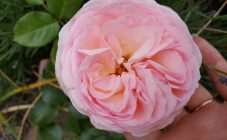Content:
There are a large number of subspecies of roses: spray, tea-hybrid, floribunda, English roses. Climbing roses should be considered separately - these beautiful "flower queens" will look good in single plantings, such bushes can be used if you need to fill a small empty area.
This article will tell you about one of the most beautiful varieties among climbing roses - the Exelz rose, its main characteristics, the nuances of planting and growing, as well as the advantages and disadvantages of this perennial.
General information about climbing roses. The history of the creation of the Excelsa variety
The exact definition of this group of roses is not given. The main thing that distinguishes these perennials from other varieties of rose bushes is the shape of the bush itself. The length of the stems of this perennial reaches 3-16 m, for example, the Chinese rose Gigantea. Such a long shoot length is the main difference between climbing roses.
These flowers, according to experts, were the progenitors of modern varieties of such roses, a distinctive feature of which is abundant flowering throughout the summer season. Elongated shoots can hang down or actively grow up.
These varieties are used by flower growers and landscape designers to decorate the walls of country houses, gazebos, and fences. Climbing roses can also be planted where bald spots suddenly appeared on the territory of a garden or park, which do not look at all aesthetically pleasing.
Rose Excelsa is a fairly old variety - it was bred at the beginning of the last century by the American breeder Michael Walsh, and in the international classification of rose varieties it is listed in the "Wichurana Hybrid" section. This climbing "queen of flowers" has another name - "Red Dorothy Petkin", by which she is known not only in the United States of America, but also in several other countries of the world.
Characteristics and description of the variety
Climbing rose Excelsa is one of the most unpretentious flowering perennials, it can grow on almost any, even completely infertile soil, bloom profusely even in a shaded place. But this is not all the advantages of the climbing rose Super Excels.
All climbing "queens of flowers" are distinguished by abundant long flowering, but this variety outdid them all - when all the buds bloom on the shoots, foliage is practically invisible behind them. On each stem, from 4 to 10 buds can bloom at the same time, the diameter of fully blossoming flowers can be from 3.5 to 5.5 cm. The stem of the bush is a thick liana, the stem of which is small (about 5-9 cm). The growth force of this bush is great, the hanging stems are flexible and very long. The height of the liana can reach 3.5-4 m, and in diameter this super rose can reach 1.8-2.1 m.
The foliage is oval, slightly elongated, with sharp tips, dark emerald color with a characteristic glossy shine. The flowers are small, their base is flattened, each bud is densely double, it contains at least 85-88 petals. The flowers are collected in racemose inflorescences, in each of the inflorescences there can be at least 55-58 buds, the petals of which are painted in a pale pink color. The aroma of blossoming flowers is subtle, subtle, with hints of vanilla.
Of the other advantages of the Excels rose, it should be noted that it is highly resistant to frost, the flowers bloom even when grown in the shade. However, this flowering perennial does not tolerate the dry hot season.
This hybrid can be grown as a climbing, groundcover or standard species. Most often it is planted along low fences or next to high strong supports.
This shrub has high immunity, and resistance to most diseases is much higher than average.
Breeders continued to work on improving this climbing rose, resulting in a subspecies - the Super Excels rose has more pronounced advantages than Excels. This super variety is distinguished by its increased resistance to all diseases, but the main advantage of this perennial is that it blooms repeatedly.
The height of the Super Excelsia bushes does not exceed 1.9-2.1 m, the flowers are also small - no more than 4 cm in diameter, they are collected in large racemose inflorescences. The buds bloom on the shoots alternately, the first time this rose is more abundant in color.
Fading buds should be cut off immediately so that the plant does not lose its beautiful appearance. The leaf blades are dark emerald in color with a characteristic glossy sheen. The flower petals are deeply crimson in color, and in the middle - white, under the bright rays of the sun, the buds fade, on the reverse side of the petals acquiring a pinkish tint with a silvery tint. Super Excelsa tolerates the rainy season well, without stopping abundant flowering, is not afraid of a strong drop in temperature.
Agrotechnics
The site for these flowers should be protected from gusts of cold winds, the soil should be loose, fertile enough, well letting in moisture and air to the roots of the plant. In the morning hours, the rose bushes should be well illuminated by the sun, its rays will quickly evaporate the morning dew from the foliage. If the dew lingers on the leaf plates, this can lead to powdery mildew damage to the rose.
Planting of Excelsa seedlings should be carried out in mid-May or early June. In this case, the plant will have time to acclimatize well and gain strength before the onset of frost. It is dangerous to plant this rather heat-loving plant in autumn - if the bushes do not have time to take root before the onset of cold weather, they can freeze out, especially if these flowers are planted in the suburbs or in other regions with a similar climate.
Further care for the planted rose bushes includes:
- compliance with the irrigation regime;
- regular loosening of the soil;
- weed removal;
- adding a mulch layer after watering;
- regular feeding that promotes abundant flowering;
- pruning in the spring (if necessary and in the fall);
- regular removal of buds during the summer season.
When pruning a shrub in the spring, you should remove damaged, dried and frozen branches. It is also necessary to remove weak shoots growing inside the bush - they thicken the perennial, take away some of the nutrients necessary for the formation of buds. If Excelsa grows near a hedge or wall, then you need to remove all the buds directed to the walls. If shoots grow from them, they will deform.
Top dressing is applied several times per season: in the spring at the beginning of flowering and after flowering.
Advantages and disadvantages of the variety in comparison with others
The main advantages of the Excels rose variety include:
- abundant single flowering;
- disease resistance - above average;
- high resistance to frost;
- buds are densely double with a pale pink color of blossoming buds.
The main disadvantages of these varieties should be noted:
- a large number of thorns on the stems - this makes it difficult to care for flowering perennials;
- Super Excelsia buds can fade in direct sunlight;
- fading buds do not fall off by themselves, so they should be removed immediately so as not to spoil the decorative effect of the bushes.
Despite a number of disadvantages, climbing roses Excelsa and Super Excelsa have been popular with flower growers for a century. They are so beautiful that they will decorate any site, they can be used as a decorative decoration for gazebos, walls of garden houses, low hedges.














